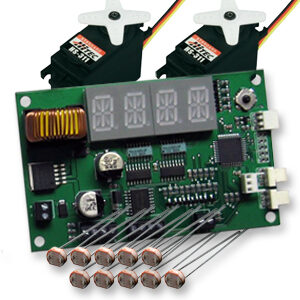Description
Introduction
The CR-2 model railroad crossing controller was designed from prototypical crossing circuits, ensuring that realistic operation is possible, even in complex layout configurations. Upon detection of an approaching train the module is designed to activate the grade crossing signals.
Signal Compatibility
The CR-2 is compatible with many crossing signal manufacturers, with configurable outputs to match the signal model requirements. Common-anode, common-cathode, H-Bridge, and prototypical railway wiring standard outputs are possible with the onboard menu system.
The CR-2 can be configured for crossings with our without gates. Gate arms can be driven with a Circuitron Tortoise motor or with two RC style servo motors. When servo motors are used, the horizontal and vertical stop points can be adjusted via the onboard menu system to ensure most realistic operation and ease of installation.
Accessories
Bell Sound
Realistic bell sounds are possible with with BL-2 pluggable accessory module. The CR-2 allows different operational modes for the bell when gates are configured:
-
- On when lights flashing
- On until gates are horizontal
- On when gate between up and down position
- On until gates pickup.
Multiple Track Crossings
Up to eight tracks are possible with the use of MT-2 extension modules. Up to 7 MT-2 modules can be used to provide a maximum of 8 mainline tracks. The CR-2 and MT-2 train detection is identical. These inputs can also be configured for active-high or active-low operation, as well as digital or analogue operation. Each input is individually configurable. Loss-of-Shunt time is also programming, which is the prototypical term for ensuring occupancy status is retained for a short period of time if train presence is lost. This is important for optical sensors or any other detection that can be intermittent.
Kit Options
The CR-2 is available in multiple kits:






Reviews
There are no reviews yet.